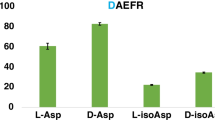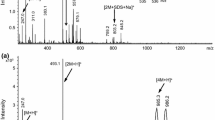Abstract
The formation of isoaspartate (isoAsp) from asparaginyl or aspartyl residues is a spontaneous post-translational modification of peptides and proteins. Due to isopeptide bond formation, the structure and possibly function of peptides and proteins is altered. IsoAsp modifications within the peptide chain have been reported for many cytosolic proteins. Amyloid peptides (Aβ) deposited in Alzheimer’s disease may carry an N-terminal isoAsp-modification. Here, we describe a quantitative investigation of isoAsp-formation from N-terminal Asn and Asp using model peptides similar to the Aβ N-terminus. The study is based on a newly developed separation of peptides using capillary electrophoresis (CE). 1H NMR was employed to validate the basic finding of N-terminal isoAsp-formation from Asp and Asn. Thereby, the isomerization of Asn at neutral pH (0.6 day−1, peptide NGEF) is approximately six times faster than that within the peptide chain (AANGEF). The difference in velocity between Asn and Asp isomerization is approximately 50-fold. In contrast to N-terminal Asn, Asp isomerization is significantly accelerated at acidic pH. The kinetic solvent isotope (k D2O/k H2O) effect of 2.46 suggests a rate-limiting proton transfer in isoAsp-formation. The proton inventory is consistent with transfer of one proton in the transition state, supporting the previous notion of rate-limiting deprotonation of the peptide backbone amide during succinimide-intermediate formation. The study provides evidence for a spontaneous N-terminal isoAsp-formation within peptides and might explain the accumulation of N-terminal isoAsp in amyloid deposits.





Similar content being viewed by others
References
Aswad DW, Paranandi MV, Schurter BT (2000) Isoaspartate in peptides and proteins: formation, significance, and analysis. J Pharm Biomed Anal 21:1129–1136
Barnett RE, Jencks WP (1969) Diffusion-controlled proton transfer in intramolecular thiol ester aminolysis and thiazoline hydrolysis. J Am Chem Soc 91:2358–2369
Böhme L, Bär JW, Hoffmann T, Manhart S, Ludwig HH, Rosche F, Demuth HU (2008a) Isoaspartate residues dramatically influence substrate recognition and turnover by proteases. Biol Chem 389:1043–1053
Böhme L, Hoffmann T, Manhart S, Wolf R, Demuth HU (2008b) Isoaspartate containing amyloid precursor protein derived peptides alter efficacy and specificity of potential beta-secretases. Biol. Chem. 389:1055–1066
Capasso S, Mazzarella L, Sica F, Zagari A, Salvadori S (1993) Kinetics and mechanism of succinimide ring formation in the deamidation process of asparagine residues. J Chem Soc Perkin Trans 2:679–682
Carter WG, Aswad DW (2008) Formation, localization, and repair of L-isoaspartyl sites in histones H2A and H2B in nucleosomes from rat liver and chicken erythrocytes. Biochemistry 47:10757–10764
Clarke S (1985) Protein carboxyl methyltransferases: two distinct classes of enzymes. Annu Rev Biochem 54:479–506
Cook PF (1991) Enzyme mechanism from isotope effects. CRC press, Boca Raton
Corti A, Curnis F (2011) Isoaspartate-dependent molecular switches for integrin-ligand recognition. J Cell Sci 124:515–522
Cox MM, Jencks WP (1978) General acid catalysis of the aminolysis of phenyl acetate by a preassociation mechanism. J Am Chem Soc 100:5956–5957
Di Fede G, Catania M, Morbin M, Rossi G, Suardi S, Mazzoleni G, Merlin M, Giovagnoli AR, Prioni S, Erbetta A, Falcone C, Gobbi M, Colombo L, Bastone A, Beeg M, Manzoni C, Francescucci B, Spagnoli A, Cantù L, Del Favero E, Levy E, Salmona M, Tagliavini F (2009) A recessive mutation in the APP gene with dominant-negative effect on amyloidogenesis. Science 323:1473–1477
Ellis KJ, Morrison JF (1982) Buffers of constant ionic strength for studying pH-dependent processes. Methods Enzymol 87:405–426
Geiger T, Clarke S (1987) Deamidation, isomerization, and racemization at asparaginyl and aspartyl residues in peptides. Succinimide-linked reactions that contribute to protein degradation. J Biol Chem 262:785–794
George-Nascimento C, Lowenson J, Borissenko M, Calderon M, Medina-Selby A, Kuo J, Clarke S, Randolph A (1990) Replacement of a labile aspartyl residue increases the stability of human epidermal growth factor. Biochemistry 29:9584–9591
Haass C, Lemere CA, Capell A, Citron M, Seubert P, Schenk D, Lannfelt L, Selkoe DJ (1995) The Swedish mutation causes early-onset Alzheimer’s disease by beta-secretase cleavage within the secretory pathway. Nat Med 1:1291–1296
He W, Barrow CJ (1999) The A beta 3-pyroglutamyl and 11-pyroglutamyl peptides found in senile plaque have greater beta-sheet forming and aggregation propensities in vitro than full-length A beta. Biochemistry 38:10871–10877
Jonsson T, Atwal JK, Steinberg S, Snaedal J, Jonsson PV, Bjornsson S, Stefansson H, Sulem P, Gudbjartsson D, Maloney J, Hoyte K, Gustafson A, Liu Y, Lu Y, Bhangale T, Graham RR, Huttenlocher J, Bjornsdottir G, Andreassen OA, Jonsson EG, Palotie A, Behrens TW, Magnusson OT, Kong A, Thorsteinsdottir U, Watts RJ, Stefansson K (2012) A mutation in APP protects against Alzheimer’s disease and age-related cognitive decline. Nature 488:96–99
Kummer MP, Hermes M, Delekarte A, Hammerschmidt T, Kumar S, Terwel D, Walter J, Pape HC, König S, Roeber S, Jessen F, Klockgether T, Korte M, Heneka MT (2011) Nitration of tyrosine 10 critically enhances amyloid β aggregation and plaque formation. Neuron 71:833–844
Lee JC, Kang SU, Jeon Y, Park JW, You JS, Ha SW, Bae N, Lubec G, Kwon SH, Lee JS, Cho EJ, Han JW (2012) Protein l-isoaspartyl methyltransferase regulates p53 activity. Nat. Commun. 3:927
Lowenson JD, Clarke S (1990) Identification of isoaspartyl-containing sequences in peptides and proteins that are usually poor substrates for the class II protein carboxyl methyltransferase. J Biol Chem 265:3106–3110
Lowenson JD, Clarke S (1991) Structural elements affecting the recognition of l-isoaspartyl residues by the l-isoaspartyl/d-aspartyl protein methyltransferase. Implications for the repair hypothesis. J Biol Chem 266:19396–19406
Lowenson JD, Clarke S (1992) Recognition of d-aspartyl residues in polypeptides by the erythrocyte l-isoaspartyl/d-aspartyl protein methyltransferase. Implications for the repair hypothesis. J Biol Chem 267:5985–5995
Lowenson JD, Roher AE, Clarke S (1994) Protein aging extracellular amyloid formation and intracellular repair. Trends Cardiovasc Med 4:3–8
MacLaren DC, Kagan RM, Clarke S (1992) Alternative splicing of the human isoaspartyl protein carboxyl methyltransferase RNA leads to the generation of a C-terminal -RDEL sequence in isozyme II. Biochem Biophys Res Commun 185:277–283
Meinwald YC, Stimson ER, Scheraga HA (1986) Deamidation of the asparaginyl-glycyl sequence. Int J Pept Protein Res 28:79–84
Ni W, Dai S, Karger BL, Zhou ZS (2010) Analysis of isoaspartic acid by selective proteolysis with Asp-N and electron transfer dissociation mass spectrometry. Anal Chem 82:7485–7491
Noguchi S (2010) Conformational variation revealed by the crystal structure of RNase U2A complexed with Ca ion and 2′-adenylic acid at 1.03 Å resolution. Protein Pept Lett 17:1559–1561
Nussbaum JM, Schilling S, Cynis H, Silva A, Swanson E, Wangsanut T, Tayler K, Wiltgen B, Hatami A, Ronicke R, Reymann K, Hutter-Paier B, Alexandru A, Jagla W, Graubner S, Glabe CG, Demuth HU, Bloom GS (2012) Prion-like behaviour and tau-dependent cytotoxicity of pyroglutamylated amyloid-beta. Nature 485:651–655
Park JW, Lee JC, Ha SW, Bang SY, Park EK, Yi SA, Lee MG, Kim DS, Nam KH, Yoo JH, Kwon SH, Han JW (2012) Requirement of protein l-isoaspartyl O-methyltransferase for transcriptional activation of trefoil factor 1 (TFF1) gene by estrogen receptor alpha. Biochem Biophys Res Commun 420:223–229
Patel K, Borchardt RT (1990) Chemical pathways of peptide degradation. II. Kinetics of deamidation of an asparaginyl residue in a model hexapeptide. Pharm Res 7:703–711
Potter SM, Johnson BA, Henschen A, Aswad DW, Guzzetta AW (1992) The type II isoform of bovine brain protein l-isoaspartyl methyltransferase has an endoplasmic reticulum retention signal (…RDEL) at its C-terminus. Biochemistry 31:6339–6347
Robinson AB (1974) Evolution and the distribution of glutaminyl and asparaginyl residues in proteins. Proc Natl Acad Sci USA 71:885–888
Robinson NE, Robinson AB (2001) Molecular clocks. Proc Natl Acad Sci USA 98:944–949
Robinson AB, Rudd CJ (1974) Deamidation of glutaminyl and asparaginyl residues in peptides and proteins. Curr Top Cell Regul 8:247–295
Robinson AB, McKerrow JH, Cary P (1970) Controlled deamidation of peptides and proteins: an experimental hazard and a possible biological timer. Proc Natl Acad Sci USA 66:753–757
Roher AE, Lowenson JD, Clarke S, Wolkow C, Wang R, Cotter RJ, Reardon IM, Zurcher-Neely HA, Heinrikson RL, Ball MJ (1993) Structural alterations in the peptide backbone of beta-amyloid core protein may account for its deposition and stability in Alzheimer’s disease. J Biol Chem 268:3072–3083
Saido TC, Yamao-Harigaya W, Iwatsubo T, Kawashima S (1996) Amino- and carboxyl-terminal heterogeneity of beta-amyloid peptides deposited in human brain. Neurosci Lett 215:173–176
Sargaeva NP, Lin C, O’Connor PB (2011) Differentiating N-terminal aspartic and isoaspartic acid residues in peptides. Anal Chem 83:6675–6682
Satterthwait AC, Jencks WP (1974) The mechanism of the aminolysis of acetate esters. J Am Chem Soc 96:7018–7031
Schilling S, Hoffmann T, Manhart S, Hoffmann M, Demuth HU (2004) Glutaminyl cyclases unfold glutamyl cyclase activity under mild acid conditions. FEBS Lett 563:191–196
Schilling S, Lauber T, Schaupp M, Manhart S, Scheel E, Bohm G, Demuth HU (2006) On the seeding and oligomerization of pGlu-amyloid peptides (in vitro). Biochemistry 45:12393–12399
Schilling S, Zeitschel U, Hoffmann T, Heiser U, Francke M, Kehlen A, Holzer M, Hutter-Paier B, Prokesch M, Windisch M, Jagla W, Schlenzig D, Lindner C, Rudolph T, Reuter G, Cynis H, Montag D, Demuth HU, Rossner S (2008) Glutaminyl cyclase inhibition attenuates pyroglutamate Abeta and Alzheimer’s disease-like pathology. Nat Med 14:1106–1111
Schlenzig D, Manhart S, Cinar Y, Kleinschmidt M, Hause G, Willbold D, Funke SA, Schilling S, Demuth HU (2009) Pyroglutamate formation influences solubility and amyloidogenicity of amyloid peptides. Biochemistry 48:7072–7078
Seifert F, Schulz K, Koch B, Manhart S, Demuth HU, Schilling S (2009) Glutaminyl cyclases display significant catalytic proficiency for glutamyl substrates. Biochemistry 48:11831–11833
Shimizu T, Watanabe A, Ogawara M, Mori H, Shirasawa T (2000) Isoaspartate formation and neurodegeneration in Alzheimer’s disease. Arch Biochem Biophys 381:225–234
Stephenson RC, Clarke S (1989) Succinimide formation from aspartyl and asparaginyl peptides as a model for the spontaneous degradation of proteins. J Biol Chem 264:6164–6170
Varshavsky A (1996) The N-end rule: functions, mysteries, uses. Proc Natl Acad Sci USA 93:12142–12149
Velazquez P, Cribbs DH, Poulos TL, Tenner AJ (1997) Aspartate residue 7 in amyloid beta-protein is critical for classical complement pathway activation: implications for Alzheimer’s disease pathogenesis. Nat Med 3:77–79
Wagenknecht H-A, Knapp H (2009) Roempp Online. Version 3.5
Weber DJ, McFadden PN (1997) Injury-induced enzymatic methylation of aging collagen in the extracellular matrix of blood vessels. J Protein Chem 16:269–281
Young AL, Carter WG, Doyle HA, Mamula MJ, Aswad DW (2001) Structural integrity of histone H2B in vivo requires the activity of protein l-isoaspartate O-methyltransferase, a putative protein repair enzyme. J Biol Chem 276:37161–37165
Young GW, Hoofring SA, Mamula MJ, Doyle HA, Bunick GJ, Hu Y, Aswad DW (2005) Protein l-isoaspartyl methyltransferase catalyzes in vivo racemization of aspartate-25 in mammalian histone H2B. J Biol Chem 280:26094–26098
Acknowledgments
We are grateful to Prof. Dr. H.-U. Demuth for his helpful comments and suggestions on the manuscript. We thank Dr. T. Hoffmann for his technical support. This work was financially supported by the Investitionsbank Sachsen-Anhalt, Grant# 1004/00082 to Probiodrug AG (StS).
Conflict of interest
BG, HC, FS, H-HL and StS are former or present employees of Probiodrug AG.
Author information
Authors and Affiliations
Corresponding author
Rights and permissions
About this article
Cite this article
Güttler, B.HO., Cynis, H., Seifert, F. et al. A quantitative analysis of spontaneous isoaspartate formation from N-terminal asparaginyl and aspartyl residues. Amino Acids 44, 1205–1214 (2013). https://doi.org/10.1007/s00726-012-1454-0
Received:
Accepted:
Published:
Issue Date:
DOI: https://doi.org/10.1007/s00726-012-1454-0




